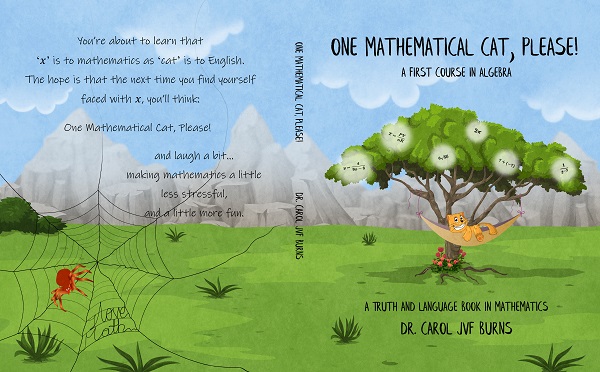ONE MATHEMATICAL CAT, PLEASE! A First Course in Algebra
This is a complete, sequenced, free, online Algebra course: no logins, no distracting ads. It has unlimited randomly-generated exercises and worksheets in every lesson, so you'll never run out of practice. Every lesson has audio with text highlighting, so you can hear the math being read aloud (by me)!
There are two versions of this Algebra course: online Algebra lessons (see below) and a printed Algebra book (which you can download for free below). They can each be used separately, but (as you'll see) they work best together. There's more info on the printed book here.
You're about to learn that $\,x\,$ is to mathematics as ‘cat’ is to English. Next time you see ‘$\,x\,$’, I hope you think One Mathematical Cat, Please! and laugh a bit $\ldots\,$ making mathematics a little less stressful, and a little more fun.

Here's an Algebra Pinball pdf that you can print out and put on your refrigerator!)
How to Use This Algebra Course
(1) Decide If It Will Work For You
Read the first online lesson: Expressions Versus Sentences. Hear my voice (yep—that's me!) by clicking the audio icon next to the title. See how the text is highlighted while I read. Try both Skill Practice and Concept Practice problems. Create some worksheets—they're different every time you click.
The online lessons are ‘in-a-nutshell’ condensations of the printed book. Sometimes, they'll be all you need. Sometimes, you'll want more—and the printed book gives you that.
To see a pdf version of the printed Algebra book, click ‘Read Section 1’ from the first column below. The entire printed book (37 sections, pdf form) is in that first column.
Like this short experiment? Then my course should be a good fit.
(2) Jump Back-and-Forth
Jump back-and-forth between online lessons and printed book—whatever works for you. But go in order, from beginning to end. Really.
Fly through parts that are easy for you, but don't skip anything. Why? This isn't a traditional Algebra course. You'll learn the language of math while you're learning algebra. There will be lots of ideas you've never seen before—miss them, and things won't flow.
Don't want to go in order? Don't despair—there's an alternative! Just read my Cat-on-Swing book first (short and easy). It gives you the math language ideas needed for all my lessons (including Geometry, Algebra II, Precalculus and Calculus).
(3) Old-Fashioned Paper and Pencil
To learn math, you've got to practice. A lot. With old-fashioned paper and pencil. (Fine—you can use a pen or a glitter marker.)
The printed book has ‘active reading’ exercises—loads of them. Read a few paragraphs, check your understanding, repeat. Tiny steps. (Of course, all solutions are included!)
By the way, these active reading exercises are not of the ‘get-up-courage-for-attack’ variety. Instead, their purpose is merely for you to take pause and digest what you just read.
You could print out all 37 sections of the algebra book (close to 400 pages), punch holes, put in a binder. But, the printed book is easier and cheaper (I did the math). Then, you can do all the problems right in the book. (Plus, it supports this website, for which you get my deepest gratitude 😊)
Let me know how things are going for you! I love to hear from my users. My email is at the bottom of my homepage. Or sign my guestbook. Or write a review at Amazon. These are all ways that I can hear your voice. 😊
Sections with the light green background are from the original ‘cat’ book (Cat-on-Swing). It was filled out to become this First Course in Algebra.
Solving For A Particular Variable
(important for science classes)
Scientific Notation and Significant Figures
(important for science classes)
A Conundrum: When is Equal, not Equal? Or, not Equal, Equal?
Prime Numbers and Related Concepts
(Short on time? Section 13.5 can be skipped without any loss of continuity.)
Applications and More
There's more! (A printed book can only be so long...) The following additional lessons have everything you need, right in the web page.
Want a print version to work away from the computer? The supplement below contains all 40 extra lessons (sections 38–47), together with a worksheet for each section. There's plenty of space to work problems right in the book.

Supplement: The Extra Sections
(Sections 38–47 + Worksheets)
Factoring a Difference of Squares
Solving Equations Involving Perfect Squares
Factoring Trinomials
Solving Quadratic Equations by Factoring
More on Quadratic Equations
Arithmetic with Fractions Involving Variables
Percent Increase and Decrease
Introduction to the Coordinate Plane
Lines
More On Lines
Functions